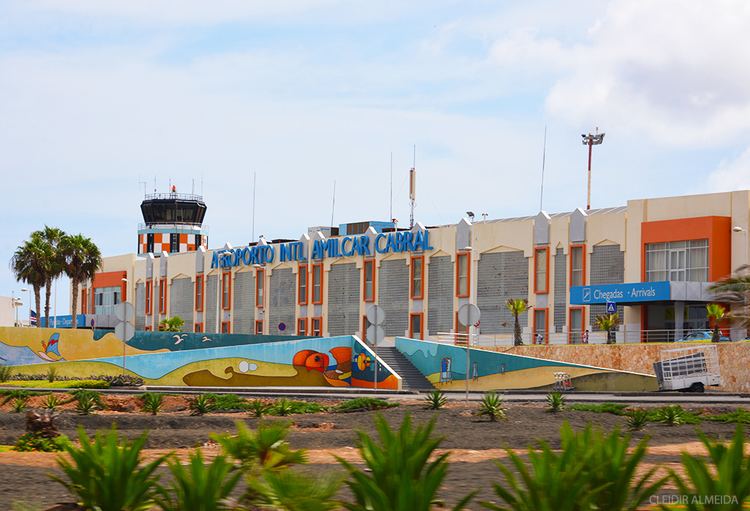Airport type Public Code SID Phone +238 241 14 68 | Elevation AMSL 54 m / 177 ft Elevation 54 m | |
 | ||
Operator Aeroportos Seguranca Aera (ASA) Hub for Cabo Verde ExpressTACV Cabo Verde Airlines Similar Meliá Tortuga Beach, ClubHotel Riu Funana, Oasis Salinas Sea, Riu Palace Cabo Verde, Hotel Morabeza | ||
Amílcar Cabral International Airport (IATA: SID, ICAO: GVAC), also known as Sal International Airport or Amílcar Cabral Airport, is the principal international airport of Cabo Verde. The airport is named after the revolutionary leader Amílcar Cabral. It is located two km west-southwest from Espargos on Sal Island. Sal was the main hub for the national airline, TACV; now it serves as a base for carriers Cabo Verde Express, and Halcyonair.
Contents
History
The first airport on Sal Island was built in 1939 by Italy, as a fuel and provisions stopping-point on routes from Rome to South America. One of the airport's architects for the terminal and its facilties was engineer Raul Pires Ferreira Chaves who was Public Works for Cape Verde. The first flight, an arrival from Rome and Seville, was on 15 December 1939. Not longer after in 1940, the project was stopped due to Italy's involvement in World War II. In 1947, the Portuguese colonial government purchased the airport from Italian interests. In 1950, DC-4 service on Alitalia began on a Rome —- Sal —- Buenos Aires —- Caracas route. In 1961 jet service (a DC-8) on the route rendered the stop at Sal unnecessary, and international service was suspended.
Between 1960 and 1967 Sal was a stop of the Voo da amizade (Friendship Flight), a dedicated service between Brazil and Portugal. It was operated from 1960 to 1965 by Panair do Brasil and from 1965 to 1967 by TAP-Transportes Aéreos Portugueses and Varig. Only Brazilian and Portuguese citizens or foreigners with permanent residence in Brazil or Portugal could purchase tickets for those flights, which were extremely popular due to their low fares. At this time, Cape Verde was a Portuguese Overseas Province and therefore part of the territory of Portugal.
From 1963 to 1975, the Portuguese Air Force's No 1 Transit Airfield (AT1, Aeródromo de Trânsito n.º 1) was installed in the Sal airport. The AT1 supported the military air connections between European Portugal and the Portuguese African provinces, as well as serving as the operational base for the maritime patrol aircraft occasionally deployed in Cape Verde.
In 1967, Sal was used again as a refueling stop, this time by South African Airways, for flights to and from Europe, since SAA was denied landing rights by most African countries due to the international boycott of apartheid, SAA would no longer serve in around 1993. Later, Cubana and Aeroflot used Sal for refueling and passenger flights.
In 1983, South African Airlines was using the airport as a refueling stop for its Boeing 747SP service between South Africa and Houston Intercontinental Airport in the U.S.
In 1985, TACV began service to Boston, Massachusetts using a McDonnell Douglas DC-10 provided by LAM Mozambique Airlines. Boston hosts the largest Cape Verdean community in the United States. TACV flights to Boston have since been shifted to Praia International Airport. Other international destinations include inter alia Amsterdam, Lisbon, Luxembourg, Madrid, Paris and Porto. Domestic destinations include Santiago and São Vicente.
Until September 2005, it was the only airport in Cape Verde to serve international flights. South African Airways served two more flights with the United States with New York and Atlanta, SAA used the airport until July 1, 2006, its final flight was with Atlanta. In 2011, the airport served 576.323 passengers.
With its modernization, the airport including its terminal, the airport was ranked in the first category of the United States Department of Transportation.
Terminal
Amílcar Cabral has one terminal. It is a two-story building containing check-in, waiting, and arrival areas, as well as shopping, banking, and passenger services. The second floor houses airport operations and airline offices. There are four gates, and buses (Cobus 3000s) are used to transport passengers to the aircraft stands.
The head office of Halcyonair is located in the first floor of the Concourse Hall. In addition Cabo Verde Express has its head office in the Concourse Hall. The duty-free shop is located after passport control but before security scanning, which only takes place as you enter the boarding lounge, which is shared for all four departure gates.
Runways
The airport's main runway is 3,272 m (10,734 ft) long and is the longest in Cape Verde. It is used for long-haul flights. It was also one of the designated emergency landing strips for the U.S. Space Shuttle. The second runway is 1,500 m (4,921 ft) long and was used by small planes. It is now closed for traffic.
Access
The airport is located on the west side of the road linking Espargos and Santa Maria, the island's main tourist destination. There is no scheduled public transport; taxis, shared cars known as "aluguer", and rental cars are available.
